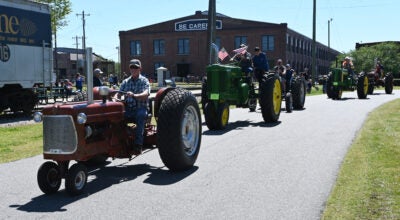Three decades ago, Historic Salisbury Foundation bought Grimes Mill
Published 12:00 am Tuesday, October 2, 2012
Historic Salisbury Foundation is celebrating its 40th anniversary year. This article about the foundation’s purchase of Grimes Mill appeared in the Salisbury Post Nov. 18, 1982.
Historic Salisbury Foundation officials announced this morning their plans to purchase the 1896 Grimes Mill, mysterious and shabby from the outside and an engineering marvel within.
Foundation president Ed Clement said fundraising efforts would start immediately to raise the asking price of $60,000. The foundation will assume possession of the property at the beginning of 1983, Clement told a gathering of about 50 community leaders at the mill site this morning.
Located at 600 N. Church St, the building is presently owned by Robert D. Davis, operator of the W. A. Davis Milling Co. of High Point.
Davis Milling still operates a small retail outlet for its various milled products and custom grinds feed. Flour for human consumption has not been produced here in about 11 years. The only flour product made recently has been that used as a glue extender, according to Lou Hill, one of two employees at the old roller mill.
“This is a unique historic property that is highly significant because of its quaint Second Empire architecture and five floors of early machinery still intact in the original part of the mill,” Clement said in a prepared statement.
“Our opportunity now is to save and stabilize the mill and open it to the public sometime in 1983.”
Hill took Clement, HSF Executive Director Anne Williams and representatives of the news media on a brief tour of the mill Wednesday afternoon.
Named for the J.D. Grimes family, longtime owners, the mill was originally built in 1896 by the North Side Roller Mills Co. It went bankrupt and was purchased by the Grimes family in 1906. By 1912, a mammoth addition including 12 giant storage bins for wheat was constructed.
The storage bins are capable of holding 90,000 pounds each, or 20,000 bushels of wheat in total. A small department to produce meal or feed from Rowan corn also operates at one end of the large addition, whose wheat is sent from the storage bins to the main building through a large steel pipe.
At its peak production in the 1930s, the mill produced about 100 barrels of flour per day. While Rowan County farm wagons were known to line up to Main Street waiting to unload their bushels of wheat, the quantity still wasn’t enough to meet the annual demands.
More wheat came in by rail, explaining the mill’s almost hovering appearance over the tracks on North Church Street.
John Grimes and his four employees closed the company in March, 1963. Davis bought it three months later intending to continue making family flour, custom grind grains and install a pigeon pellet operation. Davis also added the retail store at that time.
Hardly any merchandise exists in the store today. It acts more as the conduit from the old 1912 addition to the even older more impressive original roller mill operation, whose machinery weaves in and out of five floors.
Briefly, the milling process involved the wheat coming from the storage bins to tempering bins on the first and second floors. There it was prepared for grinding through an elaborate up and down framework of wooden ducts and six different sets of rollers.
Along the way were items such as wooden pulleys, leather belts, silk, sieves, whip sifters, dustless receiving separators and horizontal double wheat scourers.
“Yeah, they had to know what they were doing,” Hill said of the men who originally put the machinery together. “If I’d been here 25 years, I still couldn’t answer all the questions. I sure don’t know all there is to know about it.” Hill has worked here about two years.
The process eventually offered bran and shorts – packaged and sold as livestock feed – and the flour. At the end of the line the flour was bagged, and the bags immediately sewn shut.
Two interesting aspects of the mill are its utilization of space and its overall sturdy construction of wood. Immense support beams run throughout the original half and the 1912 addition.
“You know that’s what puzzles me,” Hill said from the fourth floor of the original building. “How did they get these big timbers and heavy machinery up here?”
The machinery first operated by steam, but was later converted to electric. One huge motor still operable in the basement, lends power for the whole process.
Workers are able to go from top to bottom on an old electric-powered conveyor belt operating as an elevator on a yank-to-pull, yank-to-stop principle.
Everywhere lies the dust of more than 80 years of milling wheat. Cobwebs and the maze made by the machinery add to spookiness of the building, whose Second Empire design dominates the skyline in its neighborhood by virtue of its position on a hill.
The mill would be the second foundation-owned property to be opened to the public as a museum. The foundation offers regular Sunday tours and tours by appointment of its Hall House on South Jackson Street.




